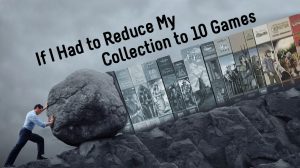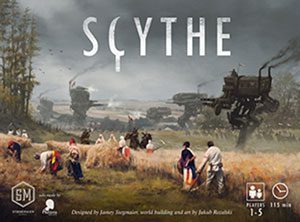 Kickstarter is quickly becoming a common way in which new board games are released and for good reason. The basic premise of Kickstarter is to fund projects from creators who may not have, or may not want, the buy-in from a major entity. This premise rings strongly in the board game community, allowing designers like Jamey Stegmaier to successfully fund eight projects, including the mega-hit Scythe, without working with a giant in the board game industry.
Kickstarter is quickly becoming a common way in which new board games are released and for good reason. The basic premise of Kickstarter is to fund projects from creators who may not have, or may not want, the buy-in from a major entity. This premise rings strongly in the board game community, allowing designers like Jamey Stegmaier to successfully fund eight projects, including the mega-hit Scythe, without working with a giant in the board game industry.On his blog, Jamey conveys that Kickstarter is a place where the participants can express their passion for something. Jamey and board game designers in general, share that passion with their backers and Kickstarter is the ideal environment for that passion. If you’re interested in a deeper dive into Kickstarter philosophy, Jamey’s blog is a great read and he’s even written a book about running Kickstarters.

One of the bigger players in the board game Kickstarter world is CMON Limited , formerly known as CoolMiniOrNot. Starting with Zombicide in 2012, CMON has been a part of some of the biggest board game Kickstarters including the recently finished Rising Sun. I, and many others, were eagerly awaiting the start of the Rising Sun campaign and I backed the campaign as quickly as I could. It turns out that 12,960 people, like me, backed Rising Sun on the first day of the campaign totaling $1,280,131 (the initial goal was $300,000) in funding. Wow.

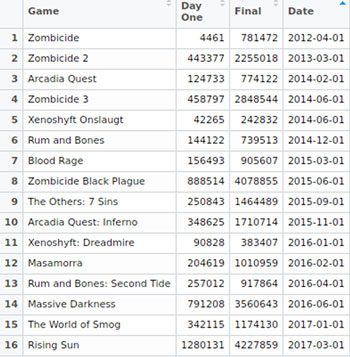 With a final funding of $4,227,859, the Rising Sun campaign ended its funding period as the most funded CMON Kickstarter to date. One of the interesting features of this campaign was that CMON didn’t release stretch goals until after the campaign and the later ones were only revealed as the previous funding targets were reached. Since this isn’t CMON’s first massively hyped Kickstarter, this got me wondering if that was because CMON wanted to get an idea for where the funding would end up for the Rising Sun campaign. So I went to kicktraq.com and, for 16 CMON campaigns, I collected the funding total from the first day of the campaign, the final funding of the campaign, and the month and year the campaign
With a final funding of $4,227,859, the Rising Sun campaign ended its funding period as the most funded CMON Kickstarter to date. One of the interesting features of this campaign was that CMON didn’t release stretch goals until after the campaign and the later ones were only revealed as the previous funding targets were reached. Since this isn’t CMON’s first massively hyped Kickstarter, this got me wondering if that was because CMON wanted to get an idea for where the funding would end up for the Rising Sun campaign. So I went to kicktraq.com and, for 16 CMON campaigns, I collected the funding total from the first day of the campaign, the final funding of the campaign, and the month and year the campaign
Hypothesis
Looking through the data, the first Zombicide game is an outlier since the first day funding was so low relative to final funding. That campaign was the first big hit for CMON and, from what I can tell, it set them up for much of their future success. To test if we can predict final funding from day one funding, I built a statistical model using linear regression (remember y=mx+b from algebra?). In this analysis, I held out Zombicide since it was before the CMON Kickstarter boom and I held out Rising Sun since I wanted to see if it fit with the rest of the data. Here is what the results show. There is another version of the graph annotated with the names of the games below.
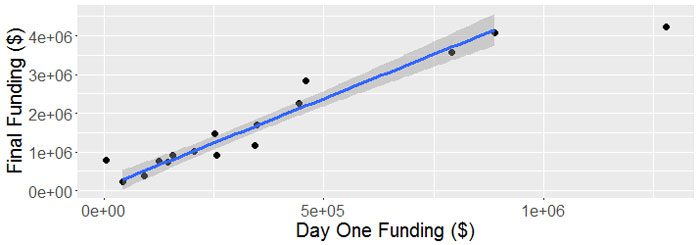
Each point on the graph represents one Kickstarter campaign and the point all the way to the right is Rising Sun. In this model, Rising Sun is an outlier. Here’s the annotated graph

So what does that mean? Basically, it means that a much larger percentage of the total funders backed Rising Sun on the first day of the campaign than expected. Now this is interesting, but it doesn’t take into account another important piece of information. How do these results change over time? To look at that, I focused on the percent of the total funding that came in on the first day for these same 16 campaigns relative to their start date.
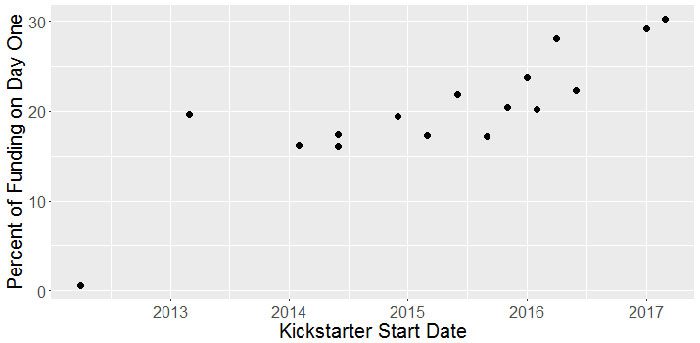
And an annotated version

Possible Conclusions
What we can see from here is there is a trend. As time goes on, a larger and larger percentage of people are funding the campaign at an earlier date. There are several possible interpretations of this phenomena. The increased exposure of these campaigns might be drawing people in sooner, backers may be less interested in the stretch goals or may be less driven to back by add-ons, many of these games are sequels which may increase the hype. Or it’s also likely that CMON’s contact list has just grown so large and they know how to tap into the excitement of the board gaming community.
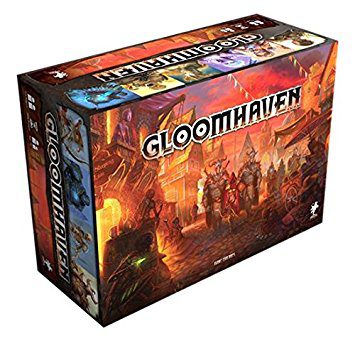
It’s clear Kickstarter is here to stay. Since the end of the Rising Sun campaign, a second printing of Gloomhaven reached over $1 million in funding on its first day, Hardback, a “Pre-Quill” to my favorite deck-builder Paperback, began its campaign and surpassed four stretch goals, and just thinking about Kickstarter has gotten me excited for the new version of Brass from Roxley games.
Kickstarter is an ever-growing phenomenon and we as a community are just beginning to understand it. Going through this quick study makes me wonder if this trend is present in other Kickstarters, if there is an ideal time to release add-ons, and if reaching stretch goals causes new backers to add on to the project.
What Kickstarter questions do you have? What are your favorite Kickstarter campaigns you’ve been a part of? Let us know in the comments below.




